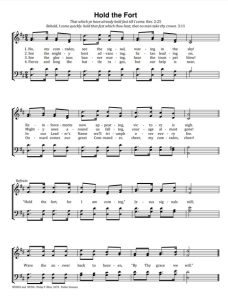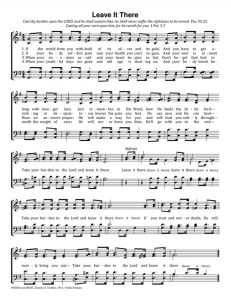When you think of a hymn, what sound, mood, and/or style pop into your head? In a typical Methodist, Episcopalian, Lutheran, etc. worship setting, I think that we can all agree that we would expect to hear something similar to the sheet music below written by Philip Bliss: 4 system, 4 verse, chordal song, verse-refrain format, etc.
Although, when looking into various Gospel hymns of the 20th century, I noticed something different about these hymns, particularly when performed or recorded. Listen to this version of “Hold the Fort” that was recorded in 1899.
https://www.loc.gov/item/99470814/?&embed=resources
As you can hear, it is not sung as “straight” as some scholars would maybe expect this song to be sung in a typical church setting. There are rhythmic and slight melodic liberties taken- from rubato to sliding up to certain notes and cadence points. In another example that I looked into, this song “Leave it There (Tkae Your Burdens to the Lord)” written by Charles Tindely- a widely renown black gospel hymn composer- was notated in the same format as seen before in 1916.
After looking at this sheet music, take a listen to another recording that was done for this song. Notice the elements that I discussed earlier about “Hold the Fort”:
As you can see, this recording done by Washinton Philips in 1927 is a lot different than what you would expect to hear. The instrumentation is “stripped”, having a “folk sounding accompaniment with some sort of sound player or maybe guitar or keyed instrument. There are obvious liberties taken in the vocal line, giving it a very inviting and easy flow. As you can also notice, the lyrics are mostly the same with slight variations occasionally in the verses.
Here is one more recording on Naxos of the same song that might throw you for a bigger loop:
Movement Soul Vol. 2: Leave It There- Tindley
This version was recorded in 2005, almost a whole century after it was written. From the folk-style strumming guitar instrumentation, the “gumption” and liberty in the melodic line, this song is not one that I can see myself singing at a Methodist worship service. This makes me want to stand up, raise my hands, and sing along as loud as I can.
You might be wondering if there is an explanation for the “contradictions” that you found between looking at the notated music vs. listening to these recordings. I can assure you that there is. According to an article written by Shana Mashgo talking about Black Church Music History, folk spirituals- “ sung a cappella and included the melodies, chord progressions, and rhythms of West African music”- were some of the first forms of church music that African American slaves created (Mashego). Types of traditions like the Ring Shout included aspects like improvisation, repetition of words and melodies, hand-clapping, and a fast-driving tempo. As it can be seen these traditions created by African American slaves translated into the way that they went about hymnody in their “formal” worship services. Hymns were always a huge part of their worship, and some scholars (especially ones like George Pullen Jackson) would believe that this was simply a learned practice from their white counterparts and slaveowners. However, black hymns were not simply sung exactly as written:
“The black church used most of the lyrics of the hymns and changed harmonies and rhythms to suit their preferences. These “made-over” hymns were passed down orally from congregation to congregation. Black hymn writers, that is, those trained to write and reproduce music in print, did not emerge until the beginning of the 20th century” (Mashego).
There was freedom in these hymns. The folk spirituals that grounded the African American music tradition in American then translated to their hymns in a churh setting. Scholars like Jackson only seemed interested with the notes on the page- what was written and notated. He expressed no knowledge of knowing the “spirit” in these hymns and where they derived from. He didn’t care to mention that there were composer like Charles Tindley that didn’t just write hymns, but who would eventually write hymns that would even be considered “traditional” or “unknown.” He didn’t make the connection that black hymns derived from the folk spirituals that were created and orally passed on by black slaves. We can hear the folk interpretations of the hymns in these recordings so clearly. The argument ultimately lies in the sound, not in the words or notes on a page. In looking through GPJ’s article again, it is clear to see that he most likely did not even try to step foot in a black church. Assumptions and large generalizations were made.
It is clear to see that gospel hymns are a clear part in American Church Music history. As we look further and deeper into the history of American Music, I hope it is clear to see that there are obvious flaws in the way scholars have gone about researching, and we, as musicologists, need to take information that is given and dive deeper into these traditions that can so often be glossed over and generalized about.
Sources Used:
Bliss, P. P, and Len Spencer. Hold the Fort Gospel Hymn. [United States: E. Berliner’s Gramophone, 1899] Audio. Retrieved from the Library of Congress, <www.loc.gov/item/99470814/>.
Mashego, Shana. “Black Church Music History.” The American Mosaic: The African American Experience, ABC-CLIO, 2021, africanamerican2.abc-clio.com/Search/Display/1591446. Accessed 4 Oct. 2021.
Malotte, Albert Hay, et al. MOVEMENT SOUL, Vol. 2. Naxos Digital Services US Inc.


